Scale on Plants: How to Kill Scale Bugs (Scale Insects)
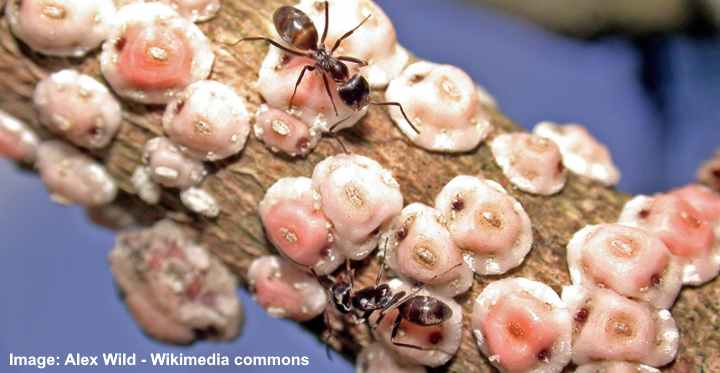
Scale insects are destructive houseplant pests that look like small bumps on plant stems and leaves. Scales can do a lot of damage to houseplants and outdoor plants. The pesky scale bugs bite into plants to feed on the sap, resulting in discolored leaves, leaf drop and stunted plant growth.
Scales are small bugs in the insect order Hemiptera. There are 8,000 species of scale bugs. Their name comes from the scale-like waxy covering that many species of scale insects have.
Most types of scale insects have oval-shaped bodies. Scales are crawling insects that can’t fly, and they infest plants by moving from one to another. Scale insects do damage to plants by their mouths, which pierce plant tissue and suck sap.
In this guide to scale insect control, you will find out how to get rid of these plant-destroying bugs on houseplants and outdoor plants.
What do Scales on Plants Look Like?
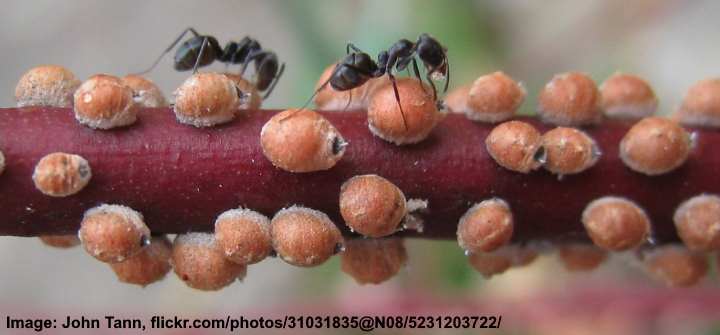
Scale insects include many species that range in color and size and look like round bumps on the plant
Scale insects on plants look like small brown or cream-colored bumps that are easily mistaken for plant growth. Scale bugs are plant pests with round or oval shape and range in size from minuscule dots to large lumps. When scales reach adulthood, they don’t move on plants, making them hard to identify.
Looking at pictures of scale bugs, recognizing them as insects can be tricky. Their shiny oval bodies attach to plant stems or leaves. The scales can be tiny pests, measuring 2 mm, or larger bugs up to 5 mm in diameter.
In time, scale insects clump together on stems, looking like lumpy plant growth. Even though the bugs don’t look like they are moving, they are constantly feeding on the plant’s sap. Looking closely, you will also see a sticky liquid on the round shiny bodies that the sap-sucking bugs use as protection.
Male scale insects look entirely different from female scale bugs. The males look more like tiny flies. However, because they only live for a few days, you will rarely see these pests on plants.
Life Cycle of Scale Insects
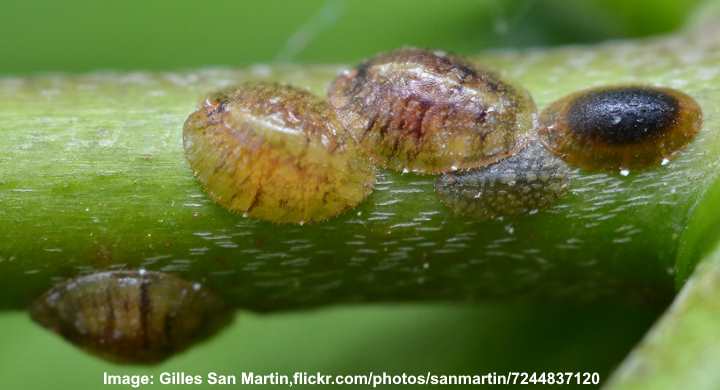
Scale life cycle starts as an egg before going through 2 growth stages and then becoming an adult
The life cycle of scales starts as an egg before going through two growth stages (instars) and maturing as adults. A Mature female scale produces eggs that hatch into yellowish nymphs (first instar) that crawl to find a place on the plant and then stays there feeding into adulthood. The bugs might never move from that spot.
It’s during their adult stage when scale bugs do the most damage. The female insects stay at the same spot, sucking the plant’s sap. During this time, brown or white scales appear on the bugs for protection. The females lay eggs, which are hidden under their bodies. When the minuscule insects hatch, they crawl to another place on the plant.
But because there is generally no movement through their life cycle, identifying scale insects is tricky.
Where do Scale Bugs Come From?

Scales often come from the outdoors as well as from new infested houseplants
Scales on houseplants often come from new plants you bring into your home. But other ways that scale insects get into the house and infest plants are from using contaminated soil, reusing an unsterilized pot, or keeping houseplants outside in the summer.
You could inadvertently bring in all sorts of plant pests—scales included—on cut garden flowers or fresh produce from the store. According to the University of California, tiny scale insects can get into a home on the wind through open windows. (1)
But it doesn’t matter how scales get into your home, if you’ve got problems with a scale bug infestation, then getting rid of them fast is your top priority.
How to Identify Scales on Houseplants
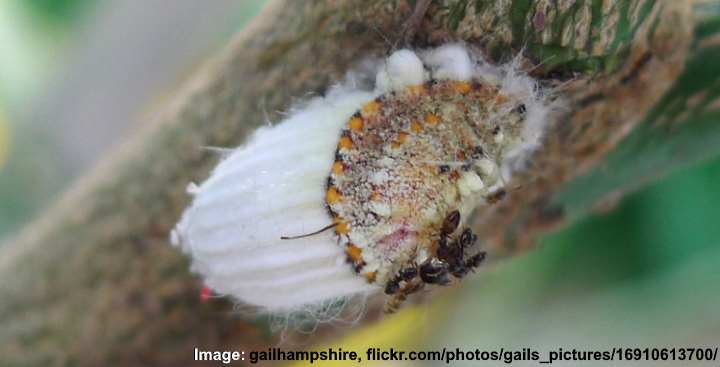
The cottony cushioned scale in this image has a soft furry covering
Identifying scale insects on houseplants requires looking for unusual bumpy growth on stems and the underside of leaves. If you’ve got a scale infestation, you’ll notice brown shell-like scales stuck to the plant. There may be evidence of honeydew and sooty mold if your plant has scales.
A common way to identify scales plant insects is by the damage the pesky bugs cause. Scales secrete a sticky substance called honeydew on the plant. The sweet gluey liquid causes black sooty mold growths. So, as well as noticing unusually tan-colored lumps on plants, the stems and leaves may be sticky and start turning black.
Types of scale insects
Three types of scale can affect houseplants:
- Armored scale bugs—These scale insects have a round, oval shape, and hard shell cover. The tiny sap-sucking pests hide under their protective scale while feeding and laying eggs.
- Soft scale insects—These destructive pests are larger than armored scale. They have a soft, furry covering and—unlike armored scale—produce honeydew from plant sap.
- Mealybugs—These nasty little houseplant pests crawl on plants leaving a cottony-wool like substance behind. Mealybugs also secrete honeydew and cause sooty mold.
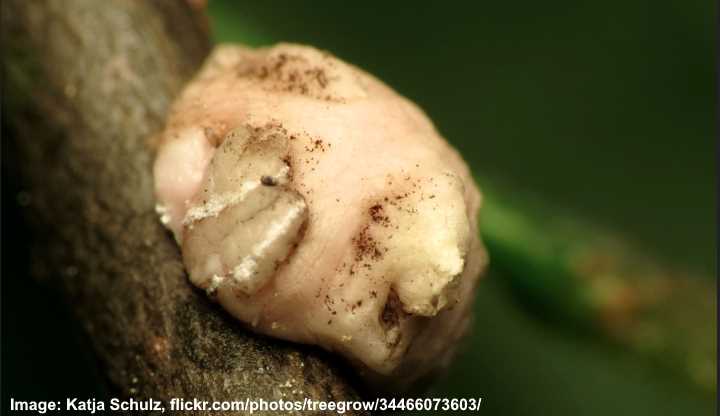
The pink wax scale in this picture is a types of soft scale insect
Scale Insect Damage on Indoor Plants
The most apparent damage that scale causes on houseplants is weak or stunted growth. Other signs of damage on scale-infested plants are yellow leaves, brown leaves, leaf drop, and dead foliage or stems. If left untreated, scales can eventually cause plant death.
The types of plant damage caused by scale insects include:
- Yellow leaves—Scale damage usually causes plant leaves to be yellow and wilted as if the plant is suffering from a lack of water.
- Premature leaf drop—The damage on the plant caused by the sap-sucking bugs causes weak growth. The result is that leaves don’t get the nutrients they require and end up dropping off.
- Black sooty mold—Honeydew excreted by scales causes black mold to grow on leaves. This substance affects photosynthesis, causing the plant to lack the food requires for healthy growth.
Although scale pests don’t damage plants as quickly as spider mites, you need to get rid of the plant bugs quickly.
How to Get Rid of Scale Insects from Plants
Before eliminating scale bugs from houseplants, you need to isolate the diseased plants from other plants to stop further infestation.
Although scale insects don’t seem to move, the tiny, newly-hatched nymphs can infest other nearby plants. It is best to avoid synthetic pesticides to get rid of scales as the bugs quickly build up resistance.
There are many suitable alternatives to toxic pesticides to get rid of scale insects. What are the best ways to eliminate scale on plants naturally? Read on to find out.
Isolate and Prune Scale-Infested Leaves and Stems

The first step when noticing scale infestation on a plant is to isolate it and remove the affected parts
After noticing signs of scale on plants such as brownish-red or white-gray bumps it’s vital to isolate the plant. It’s best to prune the affected part for heavily-infested plants to remove all traces of scale bugs altogether. Be sure to dispose of the contaminated plant parts in the trash, not compost.
Pruning is just one part of your battle to remove all signs of scale insects. Because nymphs can be hard to spot, you’ll need to use natural oil or soap sprays to debug the rest of your plant.
Use Rubbing Alcohol to Kill Scales on Plants
To get rid of scales on plant, dab a cotton swab in 70% isopropyl alcohol and apply to scale insects to kill them. For larger infestation dip a cloth in rubbing alcohol and wipe the affected leaves or stems.
The alcohol solution helps to breakdown the bug’s protective waxy layer, causing them to dehydrate and die.
Neem Oil Spray for Scale Insect Control on Houseplants

Neem oil spray is an effective way to kill scale insects on plant
To get rid of scale on plants, mix two teaspoons of organic neem oil and a teaspoon of Castile soap with a 1 quart (1 l) of lukewarm water. Fill in a spray bottle, shake well, and liberally spray all affected parts of your plant to kill the scale bugs. Use regularly on your plant until all traces of scale or other houseplant pests have gone for good.
Neem oil is a natural insecticide to get rid of scaly houseplant pests. Neem oil works to kill common plant bugs by disrupting their reproductive systems. The residual effect of neem oil means that the natural homemade scale spray continues working after applying it.
One of the advantages of neem oil is that it’s an excellent preventative control method for keeping scale away from your plants.
Researchers from Colorado State University say that neem oil is a type of horticultural oil, useful for scale insect control. To be effective in eradicating scale bugs, spraying a neem oil solution all over the plant is necessary. You will need several applications to kill off scale bugs and their nymphs. (2)
If you don’t want to make a homemade neem oil spray, you can buy commercial oil sprays for scale bug removal. Just make sure that they are natural products from organic sources to prevent toxic chemicals in your home.
Homemade Soap Sprays to Get Rid of Scale Insects on Plants

Soap spray kills scale insects on plants, vegetables and fruit trees
Soap spray is a common way to get rid of scale infestation. Fill 1 quart (1 l) spray bottle with lukewarm water and add 1-2 teaspoons of liquid dish soap or Castile soap. Shake well and spray liberally on all infested plant parts to kill scale bugs. Spray the plant as often as necessary until your plant is pest-free.
You can also use a liquid soap solution to kill scale bugs on plants. Dip a clean sponge in soapy water and wipe down both sides of the plant leaves and stems to get rid of scales. The soapy liquid helps to break down the scales coating.
After an hour or two wash the plant with a damp cloth to reduce the chance of the soap damaging the plant.
Soapy water also helps to remove honeydew and black sooty mold caused by scale bugs.
Replace the Potting Soil to Get Rid of Scales for Good
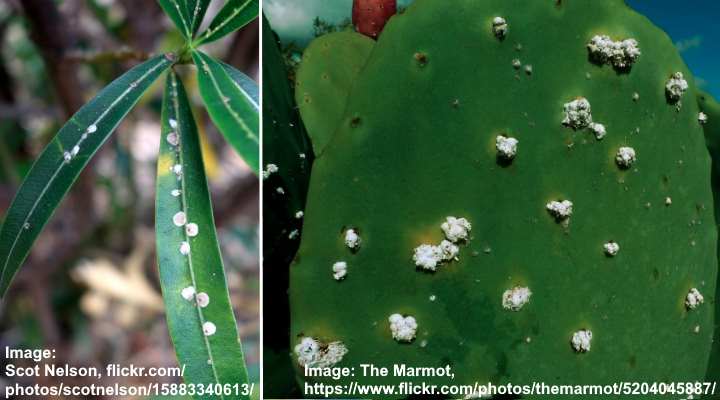
Scales can infest plant soil so repotting may be necessary
As scale bugs can infect houseplant soil, it is vital to replace potting soil to ensure you eliminate scale insects from your plants and to make sure they don’t return. Replace potting soil with a well-draining, sterile type to prevent scales returning.
Before repotting your infested houseplant, ensure you kill off all traces of scales on the plant. Then, carefully remove the root ball from the pot and dispose of all soil. Put the roots under running water to get rid of any contaminated soil. If using the same pot, thoroughly wash it with hot soapy water to sterilize it. Replace your plant in the pot and fill it with fresh soil.
Related: Common Houseplant Pests: Types, Identification, and Control
Scale Bug Prevention
After successfully getting rid of scale insects from houseplants, it’s crucial to avoid them returning. So, always inspect new plants for signs of an infestation before bringing into your house. This step is vital to prevent getting scale bugs or other houseplant pests infesting your houseplants.
Remember, if you notice one plant with a scale infestation, isolate it immediately from other plants to avoid scales making their way to other plants.
What can you do to minimize the risk of scale insects infesting your prized houseplants?
Check plants regularly for scale insects and other pests
During the growing season, inspect the underside of leaves and stem joints for signs of scales. If you notice any scale bugs, soak a cotton swab in 70% alcohol and apply directly to the bugs to kill them instantly. This prevention method will avoid an infestation from getting out of control.
What should you look out for when inspecting plants for scale pests? Here are a few telltale signs of scale problems:
- Sticky honeydew on stems or undersides of leaves
- Black sooty mold on leaves
- New, unusual growth on plants that exude fluid when squashed
- Ants appearing on your plants as they are attracted to honeydew
Spray neem oil for scale bug prevention
Spraying a natural neem oil solution on houseplants every four weeks can help prevent scale bugs from developing. Crawlers—the tiny scale bugs that emerge from eggs—are most active in spring and summer. Applying neem oil to plant foliage breaks the life cycle of scale.
Use beneficial insects to prevent scale insects on plants
Introducing beneficial insects such as ladybugs, beetles, and lacewings can help control scale populations. These predatory insects feed on scale eggs and larvae and can stop more pests appearing on plants. As long as there is something to feast on, the beneficial insects will stick around.
Using beneficial bugs to prevent scale insects is more useful for controlling scales on outdoor plants in your yard than preventing scale bugs on houseplants.
Discover how to get rid of bugs in houseplants (including identification and pictures).
Related articles:
